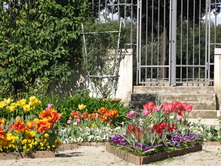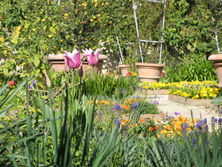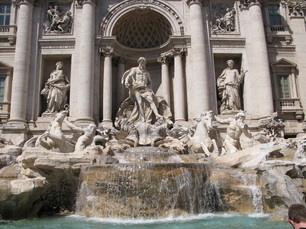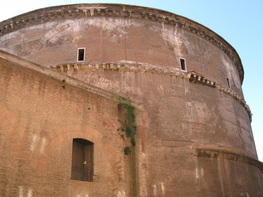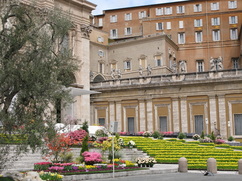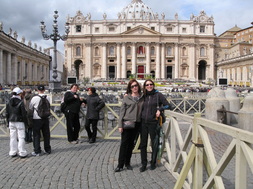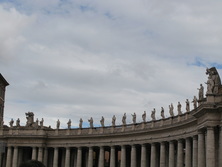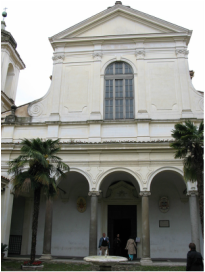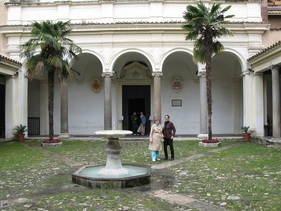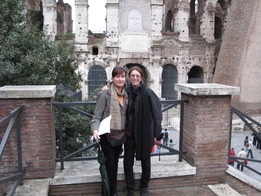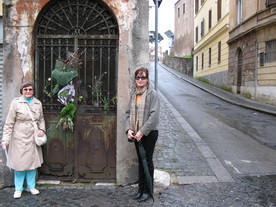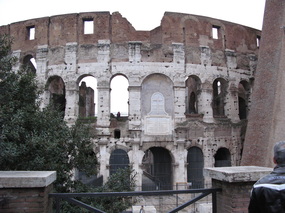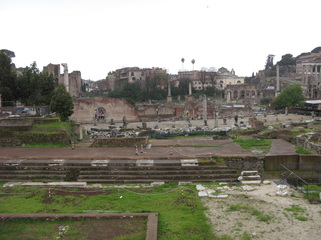Roman Holiday
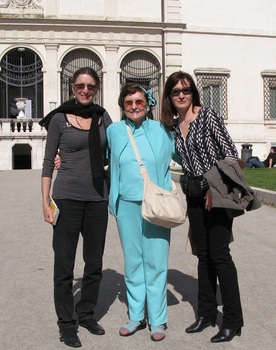
Outside the Villa Borghese
Ciao da Roma
Thursday, April 1
My mother and I arrived in Rome early morning, and were driven to my sister's fabulous apartment on a route that took us by the Palatine Hill, the Arch of Constantine, various other arches, walls, aqueducts and the Colosseum. We slept two hours and then hit the bus routes for a visit to the fabulous Borghese Gardens (including their orangerie, which was in magnificent bloom with daffodils, tulips, hyacinth, and many other spring flowers, surrounding lemon, kumquat and, of course, orange trees in full fruit - definitely a different growing zone from Toronto!)
Thursday, April 1
My mother and I arrived in Rome early morning, and were driven to my sister's fabulous apartment on a route that took us by the Palatine Hill, the Arch of Constantine, various other arches, walls, aqueducts and the Colosseum. We slept two hours and then hit the bus routes for a visit to the fabulous Borghese Gardens (including their orangerie, which was in magnificent bloom with daffodils, tulips, hyacinth, and many other spring flowers, surrounding lemon, kumquat and, of course, orange trees in full fruit - definitely a different growing zone from Toronto!)
|
On the bus back, we met a wonderfully opinionated Belgian woman who is currently living in Cannes, France, having moved there to live with her now ex-husband, but who apparently visits Rome frequently. She speaks fluent French, Italian, Flemish, English and German, if I remember correctly, and is very knowledgeable and opinionated about Rome and things Roman - past and present.
Wondering why she didn't live here as she seems to love the city, I asked her how she liked living in Cannes and whether all the festivals that descend upon that town throughout the year make life better or worse. She said the festivals are a nightmare for the residents of Cannes, but she hates living there anyway because she detests the French! I suspect this might have something to do with the "caaad" who was her husband before she "threw heem out" (think Italian/French/Flemish accent on those three words, please). What a wonderful character, but we did begin to tire of her opinions. |
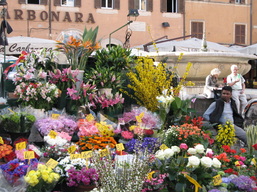
Flower Market at Campeau de' Fiore
Once we parted ways with this puzzling Francophobe at the Vatican City underground bus stop, we continued on along the Lungo Vevere Vallati (beside the Tiber River) for a bit before visiting the Campo de' Fiori, home of a popular flower and produce market and also of a statue of the martyr Giordano Bruno, which vividly and eloquently reminded us of how tricky and dangerous it was to be a free thinker in the so-called Renaissance. A Dominican philosopher/priest, he was burned at the stake for various heretical notions, the foremost of which was probably that he agreed with Copernicus about the Earth not being the centre of the universe.
On a more mundane note, to end the day, we also visited the Palazzo Farnese, grabbed some pizza bianca and bread at a popular bakery and headed back to the apartment for some much-needed sleep. Including the two hours that morning, I think I'd slept a total of 10 hours in the past three days.
On a more mundane note, to end the day, we also visited the Palazzo Farnese, grabbed some pizza bianca and bread at a popular bakery and headed back to the apartment for some much-needed sleep. Including the two hours that morning, I think I'd slept a total of 10 hours in the past three days.
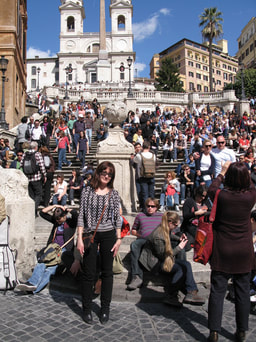 Joining the crowd on the Spanish Steps
Joining the crowd on the Spanish Steps
Friday, April 2
The start of our day found Mom and me trying to discuss two very leaky taps with the workmen who are still doing some bits and pieces on this newly-renovated apartment
my sister is in, she having an early-morning appointment. I'm sure both men were highly amused at my attempts to communicate, but they were charmingly attentive and patient, and happily my sister arrived back just in time to talk to them herself. Then off we went to visit the Quirinale (a former stables of what is now the Presidential Palace, often housing various art exhibits, the current one featuring 35 of Caravaggio's greatest masterpieces). And on to the Spanish Steps, the Piazza del Popolo, and other sites nearby...
|
Saturday, April 3
Because my sister was hosting a dinner party that evening, we shopped for food at a local market, before venturing out to visit the Trevi Fountain and the Pantheon, discovering a wonderful shop en route, which belongs to a woman in her late sixties, who has beautiful original designs in women's clothing, all of which are "artiginale" (hand-crafted). There's a painting near the front door of her mother working at a treadle sewing machine. It turns out her mother was in the same business, and possibly her grandmother, if we understood her correctly. Very lovely fashion designs created by an equally lovely woman. We went home early to prep for the women coming to dinner - which made for a fun and very loud evening. |
|
Sunday, April 4
Easter Sunday began rainy and cool, so we opted not to go to St. Peter's Square to see the service, watching some of it on television instead. A wise choice, as it gave Mom a chance to rest in the morning, before we went to visit a delightful couple from Australia for tea, stopping by the Basilica di San Clemente just down the road from their apartment. And what a perfect archaeological delight that place is, with four layers of churches built on the same site! Visitors first see a still-active and very pretty Medieval church, with the usual paintings, sculptures, niches, etc., but featuring the loveliest altar area I've seen. Small and intimate - very charming. Then down steps to a 4th Century church - frescos, more statues, etc., down again to a pagan temple to Mithras and finally to a Roman street and into what may have been the treasury of ancient Rome or the palace of someone very significant - they had running water, courtesy of one of the many artesian springs that meander throughout the city. Amazing to find oneself so far below the surface of the current Rome and standing on the cobblestones of the ancient city, listening to, and then seeing, the water rushing from the spring and channels built to harness it, just as the original residents would have all those centuries ago! Back up at the surface, there was a typical Roman Sunday flea market. In Rome, I found the street vendors polite and non-aggressive - which surprised me, having experienced flea markets in other major cities, including Paris and even Toronto, where the "hawking" is much more aggresive. We bought some very nice earrings from a lovely young woman, who seemed more concerned that we got what we wanted than simply making a sale. Walking back from tea with my sister's friends, we saw the apartment she lived in before moving to the current one, then strolled (well... sometimes huddled against the wind and rain) over to the Colosseum, the Forum and the Capitoline Hill, before returning home for dinner and sleep. |
Monday, April 5
We decided we wanted to see the flowers and olive trees brought to the Vatican for Easter Sunday. We'd admired them on the television, but they were even more stunning than we'd thought. Of course our admiration might have had something to do with the fact that my sister managed to navigate the Roman traffic chaos and find us a parking spot just below St. Peter's, which is a not-so-minor miracle! The lineups to enter the Dome went around the huge square several times, so we just took a good look at the place, the flowers, the overwhelming scope of the architecture and the statues surrounding us on the top of the walls and gave thanks for not being Roman Catholic. I'm convinced the Vatican was designed to make anyone entering the square - let alone the Dome - feel completely insignificant, disenfranchised and powerless. A clever ploy to keep the masses (pardon the pun) in check - but pretty much the same strategy used successfully by every expansionist civilization in the history of mankind, I suppose because it works. |
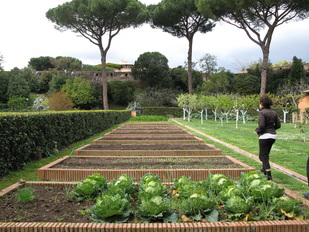 Just one of the vegetable beds at the American Academy of Rome on the Janiculum Hill
Just one of the vegetable beds at the American Academy of Rome on the Janiculum Hill
We left Vatican City to visit a friend who has a one-year fellowship at the American Academy of Rome - a fascinating piece of prime Roman real estate on the Janiculum Hill (very posh area). Once again my sister braved the traffic and got us safely up the hill. Wonderful place, where American academics and artists work collaboratively and individually. It's an independent, not-for-profit, liberal arts university, which relies on private funding, having never sought U.S. government assistance, the idea being (I believe) to keep it a truly non-partisan haven for modern "Renaissance" thinkers and artists.
Fabulous building and even more fabulous grounds, featuring extensive vegetable gardens (used by a resident famous chef, visiting culinary students and the fellows themselves), orange, lemon and kumquat trees, an olive grove, artichoke bushes and so on. It also boasts access to the place where Galileo was interned during his years on trial, and overlooks the fortress and grounds of Garibaldi's famous "last stand" against the French - the French breached the wall just at Galileo's former jail which was the highest spot in the city of its day. So much history in every square metre of the place - like all of Rome. Fascinating and humbling just to stand there!
Fabulous building and even more fabulous grounds, featuring extensive vegetable gardens (used by a resident famous chef, visiting culinary students and the fellows themselves), orange, lemon and kumquat trees, an olive grove, artichoke bushes and so on. It also boasts access to the place where Galileo was interned during his years on trial, and overlooks the fortress and grounds of Garibaldi's famous "last stand" against the French - the French breached the wall just at Galileo's former jail which was the highest spot in the city of its day. So much history in every square metre of the place - like all of Rome. Fascinating and humbling just to stand there!
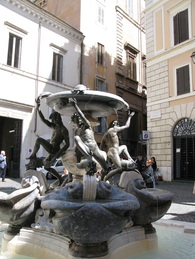
Tuesday, April 6
We visited the Jewish Ghetto where Giacomo della Porta's famous "Turtle Fountain" resides, and where there is also a famously popular and very tiny restaurant called Sorra Margherita. By waiting an hour, we managed to get in without a reservation, which is pretty much unheard of. The food was typical Roman and very well done. Delicious, and a fun place, run by a delightful man, who manages everyone splendidly. The place is considered a Roman gem by restaurant-lovers from near and far.
We visited the Jewish Ghetto where Giacomo della Porta's famous "Turtle Fountain" resides, and where there is also a famously popular and very tiny restaurant called Sorra Margherita. By waiting an hour, we managed to get in without a reservation, which is pretty much unheard of. The food was typical Roman and very well done. Delicious, and a fun place, run by a delightful man, who manages everyone splendidly. The place is considered a Roman gem by restaurant-lovers from near and far.
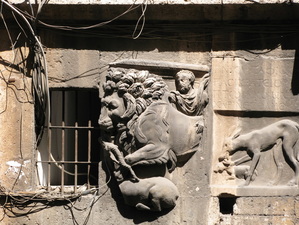 In the Jewish Ghetto
In the Jewish Ghetto
The walk through the Jewish Ghetto was a sobering part of the day - lunch notwithstanding. We visited the church (built on ancient Roman ruins, as are so many churches) where for an unknown number but many years, decades or even centuries, the Catholics forced Jews to worship as Christians. And we read the plaque that commemorates the horrible day in 1943, when, despite the fact that some good citizens of Rome had paid the Nazis the demanded tribute (gold) to leave the Jews alone, they were taken away to meet their sad fate. Of course the Nazis kept the gold and not their promise. What horrible times, but very enlightening for me to learn how many Romans tried to protect the people of the Jewish Ghetto throughout the war.
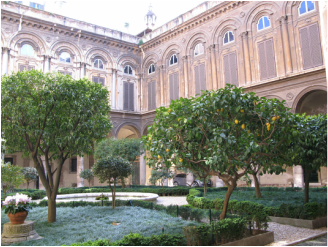 Home of the Doria Pamphiljs
Home of the Doria Pamphiljs
Leaving the ghetto, we moved on to view more amazing art in a private gallery, which is actually an old castle - home of the Doria Pamphilj family - one of Rome's most influential and powerful houses, whose numbers include more than one Pope (also a King in centuries past), including Pope Innocent, whom I think was likely somewhat less than "innocent" in spirit, mind, body and, certainly, actions. Like so many of the Pope/Kings belonging to the powerful families - Borghese, Medici, Doria Pamphilj, etc., he quite literally ruled the city, as well as the RC church.
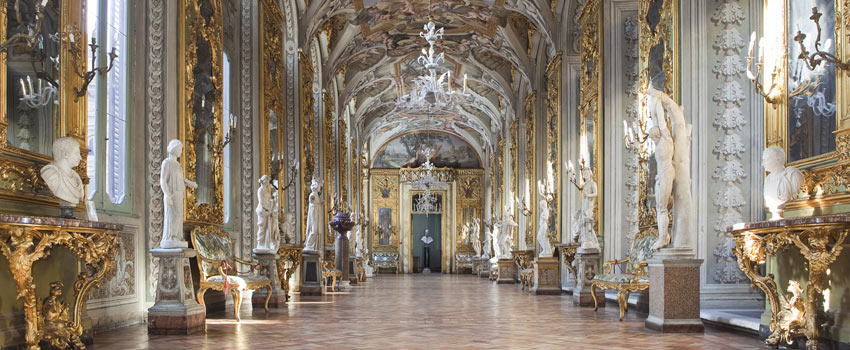
For many generations, the DPs were huge art collectors, so over the centuries, they amassed an amazing collection. And the family still owns every square inch of the palace (and also lives in part of it) including every stick of furniture (tons of gilt pieces) and every painting and sculpture. Wealth, wealth, wealth, and more wealth, dating back centuries. On a modern note, in the audio guide narrated by one of the DPs, probably in his 30s or 40s, he recounts how he and his siblings and cousins roller skated in some of the grand halls as children!
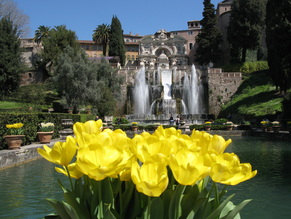
Wednesday, April 7
We had a fabulous day out of Rome, visiting the Villa d'Este at Tivoli. Amazing gardens surrounding amazingly fabulous fountains! Incomprehensible wealth that had as its possibly singular redeeming feature uncompromising artistic taste and determination. These people - like so many of their class and time - employed Bernini to design some of their fountains. He was undoubtedly one of the foremost sculptors of all time, and an obvious lover of the natural world. I suppose without the wealthy patrons, artists such as he would have been relegated to chipping stones for roads or whatever, so to everything there is a reason...
We had a fabulous day out of Rome, visiting the Villa d'Este at Tivoli. Amazing gardens surrounding amazingly fabulous fountains! Incomprehensible wealth that had as its possibly singular redeeming feature uncompromising artistic taste and determination. These people - like so many of their class and time - employed Bernini to design some of their fountains. He was undoubtedly one of the foremost sculptors of all time, and an obvious lover of the natural world. I suppose without the wealthy patrons, artists such as he would have been relegated to chipping stones for roads or whatever, so to everything there is a reason...
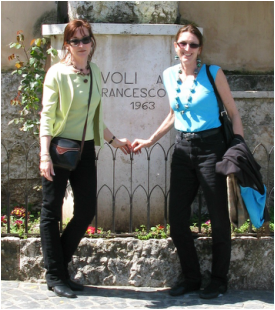 Sisters at Villa d'Este, Tivoli
Sisters at Villa d'Este, Tivoli
On a more pedantic note...the drive to Tivoli was hysterical, with my sister's very prim British Tomtom (GPS) lady voice navigating us through skinny, meandering Roman side streets, into the ugliest outskirts you could imagine, then out to the country and into the mountains, before steering us up a hair-raisingly narrow and steep lane into a dead-end construction site (tunnel, actually) on the wrong side of the town. My sister drives a 2001 Alfa Romeo, with dual transmission, which I'm sure once fulfilled some macho Italian's idea of a terrific city-country-sports-car compromise, but which lacks an actual clutch when in manual mode - so navigating steep hills on narrow mountain village streets is quite a challenge, especially as we had to come to many abrupt stops and starts on very steep parts. You have to use the emergency brake as a surrogate clutch in those circumstances. Fun, fun, fun. But definitely worth the work 'n worry to get to that fabulous fountain-filled villa.
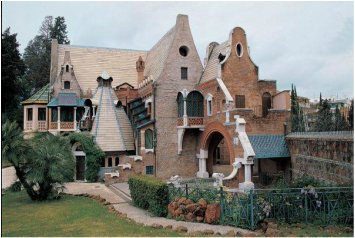
Thursday, April 8
While my sister went to work, my mother and I visited a lesser-known museum (actually three museums) at the lavish Villa Torlonia estate. This is a fascinating piece of property, which has a rich history detailing the triumphs, travails and decline of the Torloni family (another of Rome's powerful houses, with connections by marriage to the various other families, such as the Borgheses and the Doria Pamphelijs). In addition to the villa proper, the estate includes a reproduction of a frescoed Etruscan tomb, a theater, extensive gardens, a smaller residence, a large 3rd and 4th century Jewish catacomb and the wonderfully whimsical Casina della Civette, (Owl's Bungalow), built to resemble a very Italian take on a Swiss chalet.
While my sister went to work, my mother and I visited a lesser-known museum (actually three museums) at the lavish Villa Torlonia estate. This is a fascinating piece of property, which has a rich history detailing the triumphs, travails and decline of the Torloni family (another of Rome's powerful houses, with connections by marriage to the various other families, such as the Borgheses and the Doria Pamphelijs). In addition to the villa proper, the estate includes a reproduction of a frescoed Etruscan tomb, a theater, extensive gardens, a smaller residence, a large 3rd and 4th century Jewish catacomb and the wonderfully whimsical Casina della Civette, (Owl's Bungalow), built to resemble a very Italian take on a Swiss chalet.
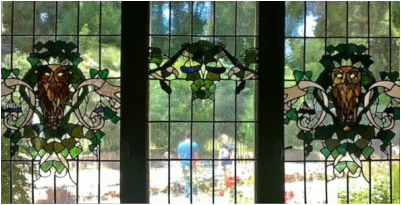
The property was turned over to Mussolini from 1925 through 1943 (he had two underground structures built to protect himself and his family during air raids and gas attacks), and was occupied by the Anglo-American forces from 1944 to 1947. (Unfortunately, they did some significant damage to the place while there.) The Casina della Civette features a fabulous Art Deco stained-glass collection. Whimsical, thoughtful, startling, stunning.
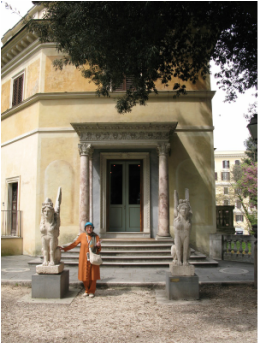
The art collections in the villa proper and in Prince Torlonia’s smaller private residence (well… smaller relative to the main “palace,” of course) feature some very interesting pieces, as well, including a haunting painting of a Roman Cardinal seated – forbidding visage, with severe lines, stone-cold stare, one eye very reddish, hands grotesquely elongated and gnarled (think F.W. Munarau's 1922 “Nosferatu” having a distant cousin, who is not-quite-undead-yet but verging on vampiric). On the C’s right, peeking out from behind the chair is a young boy – nude, and behind the C’s left shoulder is a figure that vaguely resembles one the statues featured on the top of the Vatican walls, but appearing more as a demon than an angel or an apostle. Does it take an art expert to figure out what this artist was saying?! I was surprised and encouraged that it was even hung for public view (the Villa Torlonia belongs to the city of Rome now). I am not sure exactly when it was painted or by whom (I was too stunned by the effect for logical thought), but I think it must be modern, because if it was painted in centuries past, I can't imagine the artist survived to paint another, given the wrath of the Vatican that this painting would surely have aroused!
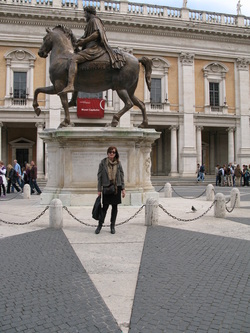 Marcus Aurelius and me - ovbiously feeling a wee tad small
Marcus Aurelius and me - ovbiously feeling a wee tad small
Friday, April 9
We spent hours at the Campidoglio (Capitoline Museum), where I'd need at least a week to do it justice. Outstanding, is the gigantic statue of Marcus Aurelius on his stallion. He's depicted as quite large for his mount, but the effect is likely just what was desired - a super-human figure, emanating virility and power.
A replica is captivating in the centre of the piazza, but the original inside is simply breathtaking! (Mom and I “modeled” in front to ensure the scale of the thing reads in photos.) That single piece is worth the price of admission and the walk up the stairway (built for horses) leading to the piazza.
We spent hours at the Campidoglio (Capitoline Museum), where I'd need at least a week to do it justice. Outstanding, is the gigantic statue of Marcus Aurelius on his stallion. He's depicted as quite large for his mount, but the effect is likely just what was desired - a super-human figure, emanating virility and power.
A replica is captivating in the centre of the piazza, but the original inside is simply breathtaking! (Mom and I “modeled” in front to ensure the scale of the thing reads in photos.) That single piece is worth the price of admission and the walk up the stairway (built for horses) leading to the piazza.
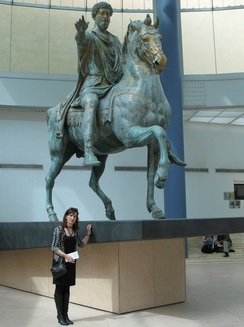 Marcus Aurelius and me again - feeling really small now!
Marcus Aurelius and me again - feeling really small now!
That the original sits in a stunning, light-filled gallery with the She-wolf (Romulus & Remus), the gilded bronze of Hercules and some remnants of the colossal bronze of Constantine (the head alone is more than six feet tall), is a bonus.
After spending quite some time simply absorbing and then photographing the figures in that one light-filled, fantastic gallery, we wandered from hallway to gallery to hallway to yet another gallery, and so on… until Mom begged for mercy and I took her back home.
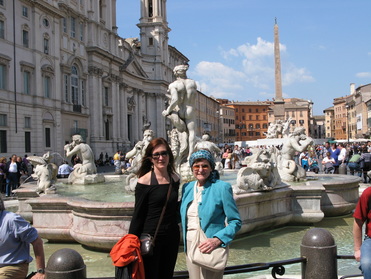 Mother and daughter at the Piazza Navona
Mother and daughter at the Piazza Navona
Saturday, April 10
More sightseeing around Rome, before attending a lecture on the life and work of Michelangelo Merisi di Caravaggio, about whom I'm ashamed to say I knew absolutely nothing before coming on this trip. Mom and I were especially lucky that my sister had booked this lecture for us in advance - courtesy of a group called the Canadian Club in Rome. The woman who gave us the lecture was very knowledgeable and insightful, and it added immensely to our understanding of the paintings when we viewed them the following Monday. Serendipity in the timing on that, as it’s difficult to get tickets on short notice to that exhibition, but my sister had already purchased them for us. The lecturer provided a clear “slice-of-life” portrayal of what it was like to be an artist in Renaissance Rome. Certainly it was (or at least aspired to be) a period of “intensified classical scholarship and humanism…” but the “humanism” seems to have been a tad low on the agenda, given how non-conforming intellectuals and artists, and common people (especially women and more especially prostitutes) were abused by the rich and powerful.
More sightseeing around Rome, before attending a lecture on the life and work of Michelangelo Merisi di Caravaggio, about whom I'm ashamed to say I knew absolutely nothing before coming on this trip. Mom and I were especially lucky that my sister had booked this lecture for us in advance - courtesy of a group called the Canadian Club in Rome. The woman who gave us the lecture was very knowledgeable and insightful, and it added immensely to our understanding of the paintings when we viewed them the following Monday. Serendipity in the timing on that, as it’s difficult to get tickets on short notice to that exhibition, but my sister had already purchased them for us. The lecturer provided a clear “slice-of-life” portrayal of what it was like to be an artist in Renaissance Rome. Certainly it was (or at least aspired to be) a period of “intensified classical scholarship and humanism…” but the “humanism” seems to have been a tad low on the agenda, given how non-conforming intellectuals and artists, and common people (especially women and more especially prostitutes) were abused by the rich and powerful.
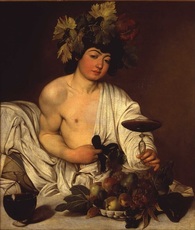 Bacchus - Caravaggio
Bacchus - Caravaggio
On a darkly amusing note, one anecdote in the lecture discussed how the women servicing the rich and powerful had to tread a very tricky path, as did the police who at the Pope’s whim, were required to monitor their curfew, while still allowing those attending to powerful men (many of them likely Cardinals) access to their clients at night. At one point, all known prostitutes were exiled from Rome, which created an economic crisis and subsequent appeal to the Pope from the merchant class, since a large part of their business relied on revenue from furniture, carpets, tapestries, linens, dishes, silverware, clothing, jewels and other items purchased by rich men for their courtesans. Needless to say, the Pope had a rethink of the situation and the “girls” promptly arrived back in town
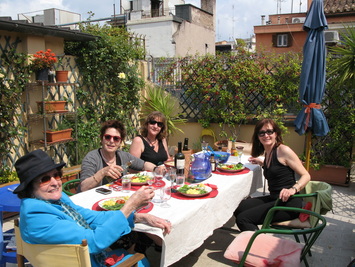
Sunday, April 11
We went for lunch to the home of a friend who is the CBS rep assigned to Vatican City. Wonderful Italian woman, who was raised partly in South Africa, attending various British boarding schools, I believe, judging by her stories and her British/Italian accent. Her flat is, as she says, "Bohemian," and it's a joy. Two terraces and access to a very large rooftop space, as well. She says she hosts great New Year's parties there, where everyone can eat, drink, dance and view the fireworks. She said we should come some year, so who knows? Great place to ring in a new year, I'd say. On the way home from her place, we visited a Portuguese church, which boasts a stunning wooden ceiling, among other features.
We went for lunch to the home of a friend who is the CBS rep assigned to Vatican City. Wonderful Italian woman, who was raised partly in South Africa, attending various British boarding schools, I believe, judging by her stories and her British/Italian accent. Her flat is, as she says, "Bohemian," and it's a joy. Two terraces and access to a very large rooftop space, as well. She says she hosts great New Year's parties there, where everyone can eat, drink, dance and view the fireworks. She said we should come some year, so who knows? Great place to ring in a new year, I'd say. On the way home from her place, we visited a Portuguese church, which boasts a stunning wooden ceiling, among other features.
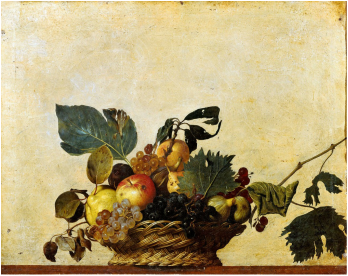 My favourite Caravaggio - not just because no one is being beheaded or tortured, but if you look closely you can see how real this basket of fruit is - decay and all
My favourite Caravaggio - not just because no one is being beheaded or tortured, but if you look closely you can see how real this basket of fruit is - decay and all
I may have my issues with the RC hierarchy, but I have to admit, collectively, that religion's wealthiest followers have commissioned, created, curated and preserved an enormous portion of the finest and most inspiring works of art in the Western World. But then, as so many Popes over the centuries were “elected” from the prominent families and were also considered kings, the families had pretty much unlimited funds to feed their collecting appetites.
I especially love the story we heard at the Caravaggio exhibit that involved the nephew (a Cardinal of course) of the Pope who coveted several of the artist’s masterpieces that had been commissioned by another wealthy noble. To acquire them, he simply had the noble arrested on trumped-up charges, which meant his possessions would be confiscated by the state, and guess who got the Caravaggios?
I especially love the story we heard at the Caravaggio exhibit that involved the nephew (a Cardinal of course) of the Pope who coveted several of the artist’s masterpieces that had been commissioned by another wealthy noble. To acquire them, he simply had the noble arrested on trumped-up charges, which meant his possessions would be confiscated by the state, and guess who got the Caravaggios?
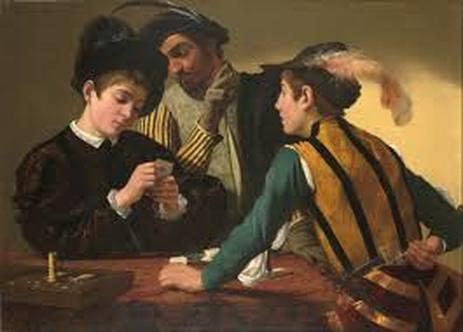 Another favourite Caravaggio - notice the card that the player on the right
is holding behind his back?
Another favourite Caravaggio - notice the card that the player on the right
is holding behind his back?
Monday, April 12
Caravaggio!!! What a short-lived genius! Art historians say he revolutionized Western art, and it’s obvious that revolution came from a deep and organic understanding of realism used to define both worldly and spiritual life - in every canvass. The exhibit, which is drawing people from all over the world, as well as a large part of the Roman population, is set in the magnificent Scuderie del Quirinale - opposite the former Papal summer residence – now the Presidential Palace - above the Spanish Steps on the highest of Rome’s seven hills. Scuderie is "stables" in English, and this stables was converted to a gallery between 1997 and 1999, by Italian architect Gae Aulenti , a woman, which, given that she was born in 1927 and into a society having very conservative attitudes towards women’s work, I think makes her an outstandingly successful pioneer in her field. One feature she left intact is the beautiful staircase, which, as with the staircase rising to the Capitoline piazza, was built so horses could make the ascent. Having ridden in my youth, I can't help but wonder what those magnificent animals thought of their masters as they dragged themselves up so many marble steps. Nevertheless, the steps themselves are brilliant works of architectural engineering.
Caravaggio!!! What a short-lived genius! Art historians say he revolutionized Western art, and it’s obvious that revolution came from a deep and organic understanding of realism used to define both worldly and spiritual life - in every canvass. The exhibit, which is drawing people from all over the world, as well as a large part of the Roman population, is set in the magnificent Scuderie del Quirinale - opposite the former Papal summer residence – now the Presidential Palace - above the Spanish Steps on the highest of Rome’s seven hills. Scuderie is "stables" in English, and this stables was converted to a gallery between 1997 and 1999, by Italian architect Gae Aulenti , a woman, which, given that she was born in 1927 and into a society having very conservative attitudes towards women’s work, I think makes her an outstandingly successful pioneer in her field. One feature she left intact is the beautiful staircase, which, as with the staircase rising to the Capitoline piazza, was built so horses could make the ascent. Having ridden in my youth, I can't help but wonder what those magnificent animals thought of their masters as they dragged themselves up so many marble steps. Nevertheless, the steps themselves are brilliant works of architectural engineering.
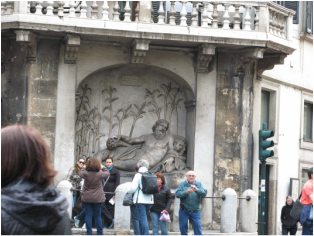
En route to the exhibit, we stopped at two lovely churches - one dedicated to a woman whose husband deserted her for another early in their marriage, leaving her to fend for herself and her children. She not only did that very well, but she also dedicated her life to helping the weak and helpless, all the while fervently believing that, through her piety and good works, she could also redeem her wandering ex-spouse in the eyes of the Lord and the Church. It turns out she did just that, as upon her death, the husband apparently had some sort of crisis of conscience that prompted him to become a key figure in the local Roman church and eventually to be ordained a priest! Does anyone out there not believe it's a man's world?!? Then again, the good woman became a saint and had a charming church built in her honour, so I guess she did okay, too – at least in the afterlife.
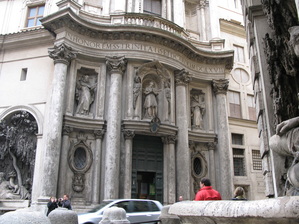
The more spectacular church on this trip was the Saint’ Andrea al Quirinale, the current version of which was designed by the brilliant Bernini and (who did it refusing payment!!!) and filled it with angels and other figures perched precariously in the ceilings of the main church and small alcoves surrounding it. With those figures, the mosaic tile work in front of the main altar, the architectural details and the frescos, it would take a very long time to see every feature in this church.
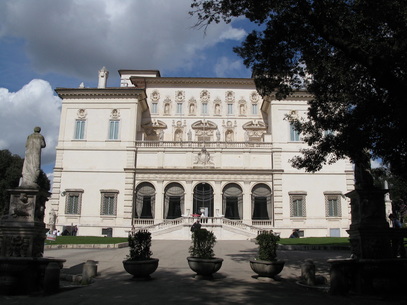 The incomparable Borghese Museum!
The incomparable Borghese Museum!
Tuesday, April 13
How to describe the Borghese Museum… Every square inch of every room is filled with sculptures or covered in art. Marble floors, inset with mosaic scenes, trompe l’oeil panels, doors and ceilings. Bernini masterpieces, such as The Rape of Persephone and Apollo and Daphne. Those two alone are worth the price of admission, if only to look in amazement at how Bernini managed to turn marble into flesh. I still can’t quite believe it.
How to describe the Borghese Museum… Every square inch of every room is filled with sculptures or covered in art. Marble floors, inset with mosaic scenes, trompe l’oeil panels, doors and ceilings. Bernini masterpieces, such as The Rape of Persephone and Apollo and Daphne. Those two alone are worth the price of admission, if only to look in amazement at how Bernini managed to turn marble into flesh. I still can’t quite believe it.
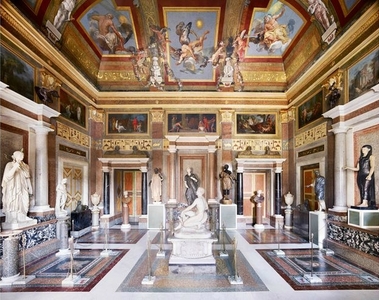 One of many equally opulent and art-filled galleries in the Borghese
One of many equally opulent and art-filled galleries in the Borghese
Then, just walking through the many, many rooms of the place, each one featuring paintings upon paintings, many by great masters, sculptures upon sculptures, including early Roman and Greek originals, more by Bernini and other classical masters, and so much more… Set in the equally magnificent Borghese Gardens (the original estate claimed a sizeable chunk of prime Renaissance Roman real estate), this place is a treasure for art and architecture lovers, historians, gardeners and arborists alike. My sister says many people consider it their favourite museum anywhere, and I can see why. The sheer, oozing opulence of it is overwhelming, so if one can just put modern egalitarian bias in one’s pocket for a bit and forget about how wickedly powerful and powerfully wicked some of these nobles were, it’s a sensory delight, and anyway, who they were, what they did, how they lived and whether the people they employed and controlled had better or worse lives because of them is, as they say, history.
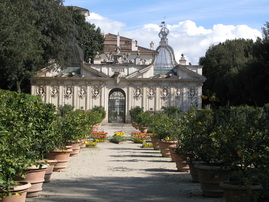 Just one section of the fabulous Borghese Gardens
Just one section of the fabulous Borghese Gardens
On the way home from the museum, we enjoyed a view of the gardens once again and of the tree-lined streets, shops and buildings along our route, which included the famous Via Vittorio Venetto.
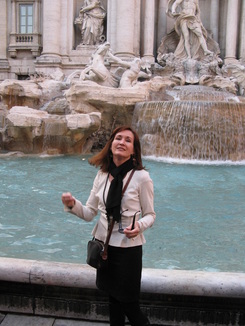 Arrivederci Roma! Tornerò per la dolce vita
Arrivederci Roma! Tornerò per la dolce vita
Later, I went with my sister to throw more coins in the Trevi Fountain, having already thrown one on the first day I visited there. I love the way the fountain simply “appears” as you meander up what seems like just another charming street. It really is unique - if spoiled for me only by the presence of a large (and – sigh – popular) McDonald’s! But then, perhaps when the world finally comes to its senses about fast food, that nutritional parasite and its ilk will fade away, while the Trevi and its many watery companions throughout this ancient city will remain – hopefully forever. So… fittingly, this visit to Rome ended with the Trevi, my sister and our coins, which perhaps will bring me back again to Roma sometime soon. (As, indeed, it did - two more times in the following three years! Again, lucky me!)
